Advance CTE’s “Research Round-Up” blog series features summaries of relevant research reports and studies to elevate evidence-backed Career Technical Educational (CTE) policies and practices and topics related to college and career readiness. This month’s blog highlights findings from a replicative study that explores educational inequity within the South Carolina CTE Health Science Career Cluster®. These findings align with Advance CTE’s vision for the future where each learner can access CTE without borders.
CTE programs offer learners the opportunity to build their awareness of different career options through exposure to activities that promote early exploration to more explicit skill development through work-based learning and apprenticeships. When well designed, these programs achieve robust and equitable enrollment that supports local and state economic growth by aligning with relevant and high-wage industries.
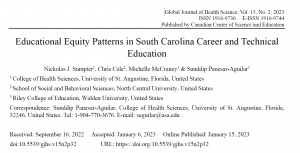 One recent dissertation, Educational Equity Patterns within South Carolina Career and Technical Education (CTE): A Replication Study, authored by Nickolas Sumpteris describes the outcomes of replicating a previous study by Fuller Hamilton. Fuller Hamilton analyzed STEM CTE enrollment patterns in Illinois by the racial/ethnic make-up and sexual characteristics of all students within the state. Since no CTE educational equity research exists in South Carolina, Sumpter sought to apply this same analysis to South Carolina’s CTE Health Science Career Cluster.
One recent dissertation, Educational Equity Patterns within South Carolina Career and Technical Education (CTE): A Replication Study, authored by Nickolas Sumpteris describes the outcomes of replicating a previous study by Fuller Hamilton. Fuller Hamilton analyzed STEM CTE enrollment patterns in Illinois by the racial/ethnic make-up and sexual characteristics of all students within the state. Since no CTE educational equity research exists in South Carolina, Sumpter sought to apply this same analysis to South Carolina’s CTE Health Science Career Cluster.
Fuller Hamilton et al. (2015) showed considerable differences in enrollment of male participants in the STEM career cluster compared to females and how these enrollment patterns correlated to other enrollment patterns within career clusters at the state and national levels. The original study also showed that all racial/ethnic groups in Illinois, except white students, were generally underrepresented in CTE programming. In addition, learners within marginalized groups identified as special populations under the Strengthening Career and Technical Education for the 21st Century Act (Perkins V) experienced significant success in obtaining high-demand skills as a pathway to college or the career of their choice when enrolled in CTE courses.
The population represented in Sumpter’s paper consisted of high school learners enrolled in CTE within South Carolina during the 2018-19 school year. Secondary data was collected from a sample of 196,318 CTE enrollees and examined using descriptive analysis procedures. Sumpter’s research questions for this replication study were:
- RQ1. What are South Carolina students’ CTE enrollment patterns, by sex, in both Health Science and Non-Health Science career clusters?
- RQ2. What are South Carolina students’ CTE enrollment patterns, by race/ethnicity, in both Health Science and Non-Health Science career clusters?
- RQ3. What are South Carolina students’ CTE enrollment patterns, by region, in both Health Science and Non-Health Science career clusters?
- RQ4. What are South Carolina students’ CTE enrollment patterns, by socioeconomic status, in both Health Science and Non-Health Science career clusters?
Findings
The study in South Carolina found inconsistencies in the levels of equity that existed within race, ethnicity, and sex. These inequities were also present regarding regional effects and socioeconomic status.
Sumpter concluded with recommendations for future research:
- Conduct a qualitative or mixed-method study to explain further the enrollment patterns of CTE programs in South Carolina.
- Address the inequities in South Carolina by:
- improving the underrepresentation of educators by sex and race/ethnicity;
- recommending equity audits;
- examining access and availability of opportunities within CTE programs;
- encouraging all educators to actively adopt and advance the equity agenda from the original study.
Additional Resources
Analyzing the Health Science Career Cluster was significant because the healthcare field represents a major employer in South Carolina and is one of the largest growing fields nationally. By improving the enrollment of underrepresented groups in the Health Science Career Cluster, South Carolina can improve the quality of life and the labor market for its residents.
State, local CTE and career pathways leaders can learn more about effectively harnessing learner group data using Advance CTE’s Achieving Inclusive CTE Goal-Setting Tool. The Achieving Inclusive CTE Goal-Setting Tool strives to equip state and local CTE and career pathways leaders to approach program participation, outcomes data, and goal setting with an inclusive and representative lens. With this goal-setting tool, leaders can more intentionally plan to recruit, engage and support underrepresented learner groups to increase access to high-quality CTE programs and career pathways.
Amy Hodge, Policy Associate
To read more of Advance CTE’s “Research Round-Up” blog series featuring summaries of relevant research reports and studies click here.


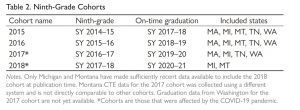
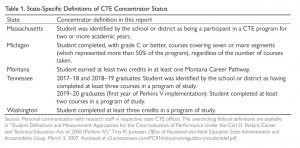
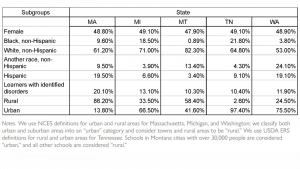

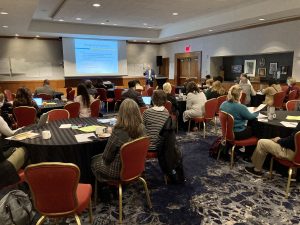 Last month, Advance CTE hosted the National Summit on Advancing Postsecondary CTE Data Quality & Use (Summit). The convening was the capstone of a two-year initiative, supported by ECMC Foundation, to support leaders in five states in cultivating postsecondary data ecosystems that assist institutions in offering career pathways that meet learner interests and are aligned to good careers. This post shares some of the main takeaways and themes from the Summit.
Last month, Advance CTE hosted the National Summit on Advancing Postsecondary CTE Data Quality & Use (Summit). The convening was the capstone of a two-year initiative, supported by ECMC Foundation, to support leaders in five states in cultivating postsecondary data ecosystems that assist institutions in offering career pathways that meet learner interests and are aligned to good careers. This post shares some of the main takeaways and themes from the Summit. The Summit also celebrated high-quality data system achievements outside of the PDI cohort. The first plenary featured a panel of Anna Fontus, Program Officer, ECMC Foundation; Su Jin Jez, Executive Director, California Competes; and Paige Kowalski, Executive Vice President, Data Quality Campaign. The panelists spoke on effective strategies to build support for California’s P20 Cradle-to-Career Data System, including:
The Summit also celebrated high-quality data system achievements outside of the PDI cohort. The first plenary featured a panel of Anna Fontus, Program Officer, ECMC Foundation; Su Jin Jez, Executive Director, California Competes; and Paige Kowalski, Executive Vice President, Data Quality Campaign. The panelists spoke on effective strategies to build support for California’s P20 Cradle-to-Career Data System, including: The second plenary session was delivered by Delaware’s State CTE Director, Jonathan Wickert. Jon spoke to the change management that enabled major shifts in the state’s postsecondary CTE data practices and system. At the center, Delaware prioritized building buy-in among staff and institution-level leaders and practitioners through many rounds of listening and feedback sessions. The state put itself in the seat of convener and let its stakeholders guide the principles and questions that would be addressed by new data routines and system requirements. This work resulted in a shared mission statement, principles and research agenda that ensures stakeholders and users needs are met by data system improvements.
The second plenary session was delivered by Delaware’s State CTE Director, Jonathan Wickert. Jon spoke to the change management that enabled major shifts in the state’s postsecondary CTE data practices and system. At the center, Delaware prioritized building buy-in among staff and institution-level leaders and practitioners through many rounds of listening and feedback sessions. The state put itself in the seat of convener and let its stakeholders guide the principles and questions that would be addressed by new data routines and system requirements. This work resulted in a shared mission statement, principles and research agenda that ensures stakeholders and users needs are met by data system improvements.  That leaves remaining challenges around data capacity. Even as youth apprenticeship programs increase their enrollment, the existing apprenticeship data infrastructure is insufficient to monitor and support these emerging programs. State and federally administered Registered Apprenticeship programs can submit data through the Registered Apprenticeship Partners Information Database System (RAPIDS), but this system cannot yet differentiate between traditional and youth apprenticeship programs.
That leaves remaining challenges around data capacity. Even as youth apprenticeship programs increase their enrollment, the existing apprenticeship data infrastructure is insufficient to monitor and support these emerging programs. State and federally administered Registered Apprenticeship programs can submit data through the Registered Apprenticeship Partners Information Database System (RAPIDS), but this system cannot yet differentiate between traditional and youth apprenticeship programs.  My name is Candace Williams and I’m thrilled to be joining the talented team at Advance CTE! In my role as Senior Research Associate, I’ll be supporting Advance CTE’s data quality and research initiatives. I’ll be working on a number of projects, including the Postsecondary Data Initiative, the Credit for Prior Learning Shared Solutions Working Group, and a forthcoming study on state Career Technical Education (CTE) funding.
My name is Candace Williams and I’m thrilled to be joining the talented team at Advance CTE! In my role as Senior Research Associate, I’ll be supporting Advance CTE’s data quality and research initiatives. I’ll be working on a number of projects, including the Postsecondary Data Initiative, the Credit for Prior Learning Shared Solutions Working Group, and a forthcoming study on state Career Technical Education (CTE) funding.